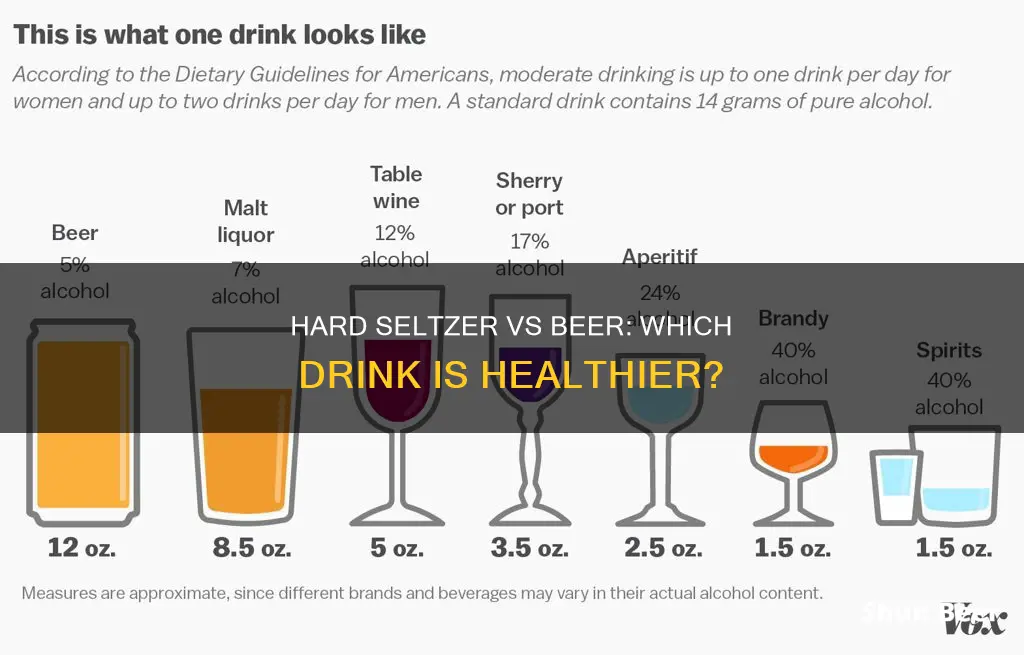
White Claw, a popular brand of low-calorie spiked seltzer, has been deemed the drink of the summer. With its relatively low-calorie content, decent alcohol content, and viral endorsements, it has become a favourite among those looking for a healthier alternative to beer. But is it really healthier? Well, it depends. White Claw has fewer calories and carbohydrates than most beers, and it's also gluten-free. However, experts argue that the perception of White Claw being healthier often leads people to drink more of it, ultimately consuming the same number of calories as they would with a few beers. Additionally, both drinks are still alcoholic, and excess alcohol consumption can lead to negative long-term health effects. So, while White Claw may have some advantages over beer in terms of calories and carbs, it's important to remember that moderation is key for overall health.
| Characteristics | Values |
|---|---|
| Calories | White Claw has fewer calories than beer. A 12-ounce can of White Claw has 100 calories, while a bottle of beer typically has 145-150 calories. |
| Carbohydrates | White Claw has fewer carbohydrates than beer. White Claw has 2 grams of carbs, while beer typically has 10-15 grams. |
| Gluten | White Claw is gluten-free, while beer contains gluten. |
| Nutritional benefits | White Claw has no real nutritional benefits like vitamins and minerals. |
| ABV | White Claw and beer typically have a similar ABV of around 5%. |
What You'll Learn

White Claw's low-calorie count is a bonus for those who want to lose weight
White Claw is a low-calorie alcoholic drink that has gained popularity, especially among younger consumers, due to its perceived health benefits. With just 100 calories and two grams of carbohydrates per 12-ounce can, it is marketed as a healthier alternative to beer, which typically contains more calories. For example, a 12-ounce bottle of Budweiser has about 145 calories.
The lower calorie count in White Claw can be a bonus for those trying to lose weight. Compared to beer, choosing White Claw can result in a modest calorie deficit. For instance, you would save about 40 calories by opting for a White Claw instead of a bottle of Stella Artois, which has approximately 150 calories. Over time, these small calorie deficits can add up and contribute to weight loss.
However, it's important to remember that weight loss is not solely about calorie counting. Alcohol, in any form, can impact your waistline and overall health in various ways. It can interfere with your sleep, hormones, digestion, and other bodily functions that affect your weight. Additionally, the drinkability of White Claw may lead to consuming multiple cans, potentially cancelling out any calorie savings compared to beer.
While White Claw's low-calorie count is a selling point, it's crucial to consume it in moderation as part of a balanced lifestyle. Excessive alcohol consumption, regardless of the type, can lead to negative health consequences.
Seltzers vs Beer: Which is the Healthier Choice?
You may want to see also

Beer has more nutritional benefits than White Claw
While White Claw has been deemed the drink of the summer, bolstered by viral endorsements, it is not necessarily healthier than beer. Both drinks are alcoholic and therefore still qualify as a "poison", as Denis Faye, M.S. puts it. Faye goes on to say that "you can still get fat from excess alcohol".
Although White Claw is marketed as a lower-calorie alternative to beer, the difference in calories is actually quite small. For example, a bottle of Stella Artois contains about 150 calories, only 40 more than White Claw. Faye says that "if you like the taste of hard seltzer, that's cool — but if you prefer beer, just have the beer".
The idea that White Claw is healthier than beer is flawed because it often leads people to drink several cans, consuming the same number of calories as a few cans of beer, and therefore not minimising any potential for weight loss.
Mead vs Beer: Which Is Healthier?
You may want to see also

White Claw is gluten-free, beer is not
White Claw is a gluten-free beverage, while beer is not. This is an important distinction, as many people suffer from gluten intolerance or coeliac disease, which can cause inflammation in the small intestine and hinder the absorption of nutrients. For these people, a gluten-free diet is the only treatment.
Gluten is a type of protein found in wheat, barley, and rye, and is therefore present in many processed foods, including bread, pasta, and beer. Beer is traditionally made with barley, hops, yeast, and sometimes wheat, all of which contain gluten. While the gluten level may decrease during the brewing process, most beers still have a gluten content above 20 parts per million (ppm). This is the threshold for gluten detection with current scientific tools. As a result, regular beer is not recommended for people on a gluten-free diet.
On the other hand, White Claw is made with gluten-free ingredients. It is a malt beverage made with selzer water, a gluten-free alcohol base, and infused fruit flavors. This makes it a suitable option for those who need to avoid gluten.
The gluten-free nature of White Claw can be particularly appealing to those who suffer from gluten intolerance or coeliac disease. It provides an alternative to beer, allowing them to enjoy an alcoholic beverage without the negative health consequences associated with gluten consumption.
However, it is important to note that while White Claw may be gluten-free, it is still an alcoholic drink. Excessive alcohol consumption can have negative effects on health, including weight gain and interference with sleep, hormones, and digestion. Therefore, while White Claw may be a gluten-free option, it should still be consumed in moderation as part of a balanced lifestyle.
The Pros and Cons of IPA Beer Consumption
You may want to see also

Beer has more variety in terms of calories and carbs
While hard seltzers like White Claw are marketed as a healthier alternative to beer, the difference in calories is pretty small. For example, a 12-ounce can of White Claw contains 100 calories and 2 grams of carbohydrates, while a 12-ounce bottle of Budweiser contains about 145 calories and 10.6 grams of carbs. However, there are some beers with even fewer calories than White Claw, such as Michelob Ultra (95), Miller Lite (96), and Corona Light (99).
The number of calories in beer can vary widely, with some as low as 64 calories in Beck's Premier Light and some as high as 175 calories in Sierra Nevada Pale Ale. Popular lite beers, including Bud Light, Michelob Ultra, Miller Lite, and Coors Light, tend to be around the 100-calorie mark, which is comparable to White Claw.
Beer also offers more variety in terms of carbohydrates. While hard seltzers like White Claw typically have around 2 grams of carbs, beers can range from less than 3 grams in Michelob Ultra to 15 grams in some craft beers.
When it comes to alcohol content, hard seltzers and beers are quite similar, with both typically containing around 5% alcohol by volume (ABV). However, it's important to read the labels, as some products, especially hard seltzers, are entering the market with higher alcohol content, such as 8-9% ABV.
In terms of overall health, experts say that neither beer nor hard seltzer is inherently healthy due to their alcoholic content. While hard seltzers have fewer calories and carbs, they offer no real nutritional benefits, and excess alcohol consumption can lead to long-term health effects, regardless of the source. Therefore, moderation is key when consuming any type of alcohol.
Beer-Battered Fish: Healthy or Harmful?
You may want to see also

Alcohol is a poison and excess consumption leads to health issues
Alcohol is a poison, and excess consumption can lead to serious health issues. Even small amounts of alcohol are linked to the development of certain diseases, including cancers. Alcohol affects both your physical and mental health and can cause short- and long-term damage to your body.
The short-term effects of drinking alcohol include hangovers, alcohol poisoning, falls and accidents, conflict, lowered inhibitions, and risky behaviours. The severity of these effects typically depends on how much a person drinks, but other factors such as hydration and food consumption also play a role. For example, drinking on an empty stomach can make a hangover more likely or more severe.
The long-term effects of alcohol consumption are more serious and contribute to more than 200 different types of diseases and injuries. These include high blood sugar, heart disease, stroke, digestive problems, liver disease, cancer, and more. Worldwide, alcohol consumption caused around 2.6 million deaths in 2019, with the highest levels of alcohol-related deaths per 100,000 persons observed in the WHO European and African Regions.
Alcohol interferes with the brain's communication pathways and can affect the way the brain looks and works. These disruptions can change mood and behaviour and make it harder to think clearly and move with coordination. Drinking a lot over a long time or too much on a single occasion can damage the heart and cause problems such as cardiomyopathy, arrhythmias, and high blood pressure.
Heavy drinking also takes a toll on the liver and can lead to a variety of problems, including steatosis, or fatty liver. Alcohol causes the pancreas to produce toxic substances that can lead to pancreatitis, a dangerous inflammation that causes swelling and pain and impairs the pancreas's ability to make enzymes and hormones for proper digestion.
Alcohol consumption is also a known carcinogen and increases the risk of several cancers, including breast cancer, liver cancer, head and neck cancer, oesophageal cancer, and colorectal cancer. Even one drink per day can increase a woman's risk of breast cancer by 5% to 15% compared to non-drinkers.
In addition to the direct health effects of alcohol, there are also social consequences. Harmful levels of alcohol consumption can lead to family problems, issues at work, financial difficulties, and unemployment. Alcohol consumption during pregnancy can also increase the risk of pre-term birth complications, including miscarriage, stillbirth, and premature delivery.
While White Claw has been marketed as a healthier alternative to beer due to its lower calorie content, the difference in calories between the two drinks is actually quite small. For example, you would only save about 40 calories by choosing a White Claw over a bottle of Stella Artois. Ultimately, the focus should be on moderation rather than the type of beverage. Excess consumption of alcohol, regardless of the source, can lead to serious health issues.
Beer Bread: Healthy or Harmful?
You may want to see also
Frequently asked questions
White Claw is an alcoholic selzter with 5% to 8% ABV. It is marketed as a lower-calorie alternative to beer, but the calorie difference is negligible. For example, a 12-ounce can of White Claw has 100 calories, while a bottle of Budweiser contains about 145 to 150 calories. Excess alcohol consumption, regardless of the source, can lead to negative health effects. Therefore, moderation is key when consuming any alcoholic beverage.
White Claw is gluten-free, making it a suitable option for those with Celiac disease or gluten sensitivity. It also has fewer calories and carbohydrates than many beers. For example, a 12-ounce can of White Claw has 100 calories and 2 grams of carbohydrates, while a Budweiser has about 145 calories and 10.6 grams of carbs.
White Claw has been criticised for its high drinkability, which may lead to consuming more calories than intended. Additionally, like beer, it provides empty calories and has no real nutritional benefits. Beer, on the other hand, may contain vitamins and minerals from the grains used in the brewing process.







